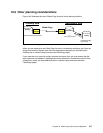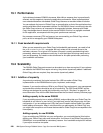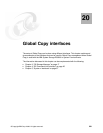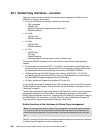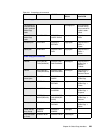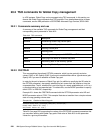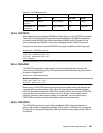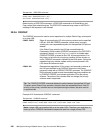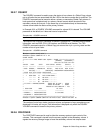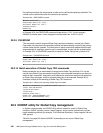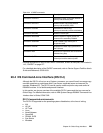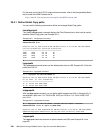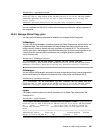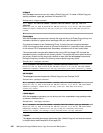
Chapter 20. Global Copy interfaces 225
Table 20-3 CESTPAIR parameter
20.2.3 CESTPATH
When establishing a path between DS6000s for Global Copy, use the CESTPATH command.
There must be a physical Fibre Channel connection between the two DS6000 subsystems.
You need to know the SSID, World Wide Node Name (WWNN), and LSS number for the
primary and secondary DS6000s. These can be displayed with the CQUERY command.
Example 20-2 show how to use the CESTPATH command to establish a Global Copy path.
Example 20-2 CESTPATH command
CESTPATH DEVN(6030) CGROUP(NO) -
PRIM(X'2060' 500507630EFFFC6F X'00') -
SEC(X'0002' 500507630EFFFCA0 X'00') -
LINK(X'00000000')
20.2.4 CDELPAIR
The CDELPAIR command is used to specify the primary and secondary volumes to be
removed from a Global Copy pairing. This command should be directed to the primary device
as shown in Example 20-3.
Example 20-3 CDELPAIR command
CDELPAIR DEVN(X'6030') -
PRIM(X'2060' AAGXA X'30' X'00') -
SEC(X'0002' AAVCA X'30' X'00')
Before issuing a CDELPAIR command, verify that there are some active paths between the
respective primary and secondary LSSs. If all of the paths that were established between
both LSSs have been disabled, the CDELPAIR command will fail. After the failing CDELPAIR
command times out, the state of the primary volume is simplex. The secondary volume
remains in its previous state (duplex, pending, or suspended). You then need to give a
CRECOVER command to return the secondary volume to the simplex state.
20.2.5 CDELPATH
The CDELPATH command is used to delete established Global Copy paths between a
primary LSS and the corresponding secondary LSS as shown in Example 20-4 on page 226.
Only the paths to the specified secondary LSS are affected; all other paths to other LSSs are
not affected.
Operation Volume pair state CESTPAIR parameter values
from to OPTION MODE
Establish initial
copy pair
simplex copy pending
XD COPY
Re-establish sus-
pended pair
suspended copy pending
XD RESYNC



